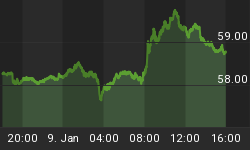The chorus calling for the Fed to facilitate higher money-supply growth has become deafening. Jude Wanniski and Larry Kudlow have been long-term members of this chorus, while gold market commentator and veteran trader Jim Sinclair has just added his voice. Apparently, as opined by Mr Sinclair in recent commentary at his web site (www.jsmineset.com), faster money-supply growth is needed now in order to avoid a 1930s-style deflationary outcome and depression. To support his view he uses charts of money-supply growth and 'money velocity', where the velocity of money is calculated by dividing the GDP growth rate by the M2 growth rate. We disagree with this chorus, and here's why.
Firstly, dividing the money-supply growth rate into the GDP growth rate tells you nothing about the velocity of money. All it tells you is how much effect money-supply growth is having on GDP growth. For example, M2 money supply has expanded by 16.8% over the past 2 years (an 8%/year compound growth rate), but this high rate of money-supply growth has had only a modest impact on GDP growth. Hence, the sharp drop in the GDP/M2 ratio shown on the below chart. This doesn't mean that the velocity of money has been low over the past 2 years, but it does indicate that money is being spent in a way that does not give a significant boost to GDP.
Further to the above, rather than interpreting the fall in the GDP/M2 ratio as a signal that we need even higher money-supply growth a more logical line of thinking would be as follows: The 16.8% increase in M2 money supply over the past 2 years has had only a minimal effect on economic growth, so the problem clearly isn't a lack of money. Higher money-supply growth is therefore not likely to make things better.

By the way, there is a positive correlation between money-supply growth and economic growth, but the correlation is based on real (inflation-adjusted) M2 growth. That is, an increase in the money supply only boosts GDP growth (with a significant lag) to the extent that it does NOT boost prices. Increases in the money supply that cause goods and services prices to increase are NEGATIVELY correlated with real economic growth.
Secondly, sustainable economic expansions are based on savings and production, not on debt and spending. One of the biggest problems facing the US at this time is that the savings rate is extremely low. Unfortunately, those who advocate monetary stimulation and other measures designed to increase the velocity of money are, in effect, advocating policies that will decrease the savings rate even further and thus DELAY the time when a sustainable economic expansion can begin. The thing that must happen now is that individual balance sheets get repaired. This is always painful in the short-term, but is absolutely necessary.
As an aside, a high savings rate alone is not enough to bring about an economic expansion. For example, the Japanese have had a high savings rate for the past decade, but economic growth has been slow. One of the problems in Japan is that a lot of the public's savings have been loaned to the Government and used unproductively as part of the Government's absurd Keynesian attempts to stimulate growth by spending huge sums on public works projects.
Thirdly and most importantly, it is a mistake to think that deflation is the problem. Deflation wasn't the problem in the 1930s and it is not the problem now. The problem in the 1930s, and the problem now, is that there was a massive asset price bubble fed by an even more massive credit bubble. Once you have allowed a massive credit bubble to form there is no 'inflating your way out of trouble'. The US money supply has expanded at a rapid rate over the past 2 years and all that has been achieved is that an even bigger problem has been pushed into the future. Read the interview with 89 year-old investment legend Seth Glickenhaus in last week's Barrons magazine, because he says it better than we do. To paraphrase Mr Glickenhaus, all the Fed does when it tries to inflate its way out of the mess it helped create is cannibalise the future. It seems as though the chorus clamouring for higher money-supply growth wants the Fed to cannibalise the future at an even faster rate.
On a related matter, in his above-mentioned commentary Mr Sinclair expressed concern about what would happen if the US stock market were 'allowed' to drop below last October's lows. However, all markets are mean reverting and over the long-term the stock market oscillates between levels of over-valuation and under-valuation. Furthermore, once it reaches one extreme and reverses course it continues in the new direction until the opposite extreme is reached. The greater the level of under- or over-valuation reached during any cycle, the further the market must move in the opposite direction once the mean-reversion process gets underway.
There are no instances in history where a government, or anyone else, has been able to prevent an over-valued stock market from following this mean-reversion process through to its logical conclusion, although governments often try. When they try, all that happens is that the bear market turns out to be longer than it would otherwise have been and each hope-rekindling bear-market rally sucks in more of the public's money. As such, the public ultimately loses more money as a result of government attempts to support an over-valued market, including the attempts to indirectly support the market by increasing the supply of money.















